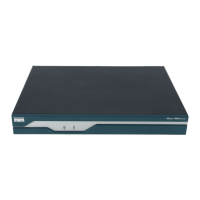15
Cisco 1841 Integrated Services Router with AIM-VPN/BPII-Plus and Cisco 2801 Integrated Services Router with AIM-VPN/EPII-Plus
OL-8719-01
Cisco 1841 and Cisco 2801 Routers
skeyid_a HMAC-
SHA-1
The ISAKMP security association authentication
key.
DRAM
(plaintext)
Automatically after IKE
session terminated.
skeyid_e DES/TDES
/AES
The ISAKMP security association encryption
key.
DRAM
(plaintext)
Automatically after IKE
session terminated.
IKE session
encrypt key
DES/TDES
/AES
The IKE session encrypt key. DRAM
(plaintext)
Automatically after IKE
session terminated.
IKE session
authentication
key
HMAC-
SHA-1
The IKE session authentication key. DRAM
(plaintext)
Automatically after IKE
session terminated.
ISAKMP
preshared
Secret The key used to generate IKE skeyid during
preshared-key authentication. “no crypto isakmp
key” command zeroizes it. This key can have two
forms based on whether the key is related to the
hostname or the IP address.
NVRAM
(plaintext)
“# no crypto isakmp key”
IKE hash key HMAC-
SHA-1
This key generates the IKE shared secret keys.
This key is zeroized after generating those keys.
DRAM
(plaintext)
Automatically after
generating IKE shared
secret keys.
secret_1_0_0 The fixed key used in Cisco vendor ID
generation. This key is embedded in the module
binary image and can be deleted by erasing the
Flash.
NVRAM
(plaintext)
Deleted by erasing the
flash.
IPSec
encryption key
DES/TDES
/AES
The IPSec encryption key. Zeroized when IPSec
session is terminated.
DRAM
(plaintext)
Automatically when IPSec
session terminated.
IPSec
authentication
key
HMAC-
SHA-1
The IPSec authentication key. The zeroization is
the same as above.
DRAM
(plaintext)
Automatically when IPSec
session terminated.
Configuration
encryption key
AES The key used to encrypt values of the
configuration file. This key is zeroized when the
“no key config-key” is issued. Note that this
command does not decrypt the configuration file,
so zeroize with care.
NVRAM
(plaintext)
“# no key config-key”
Router
authentication
key 1
Shared
secret
This key is used by the router to authenticate
itself to the peer. The router itself gets the
password (that is used as this key) from the AAA
server and sends it onto the peer. The password
retrieved from the AAA server is zeroized upon
completion of the authentication attempt.
DRAM
(plaintext)
Automatically upon
completion of
authentication attempt.
PPP
authentication
key
RFC 1334 The authentication key used in PPP. This key is in
the DRAM and not zeroized at runtime. One can
turn off the router to zeroize this key because it is
stored in DRAM.
DRAM
(plaintext)
Turn off the router.
Table 8 Cryptographic Keys and CSPs (Continued)

